On the other side of the forest -God knows which forest- lies the historically rich region of Transylvania. It is nestled cosily between the horseshoe-shaped Carpathians on the one side and the Apuseni Mountains on the other. This Summer, participants from all over Europe ventured there to uncover the mysteries of this amazing place.
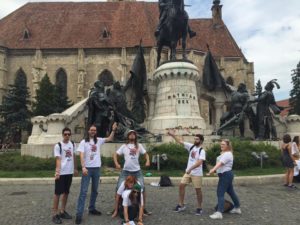 The city of Cluj-Napoca is a combination of the old and the new. It has a beautiful Roman-Catholic church with Ottoman cannonballs, fired during an attack and still stuck in its walls, behind a grand statue of the Hungarian king, Matthias Corvinus (r. 1458-1490). Opposite the church there are buildings from the Austro-Hungarian era, and behind these there are those from the Communist one. All of this shows the history of the many nations that wanted to call Transylvania their own, and nowadays it hosts the peaceful coexistence of the many peoples who have made this region their home.
The city of Cluj-Napoca is a combination of the old and the new. It has a beautiful Roman-Catholic church with Ottoman cannonballs, fired during an attack and still stuck in its walls, behind a grand statue of the Hungarian king, Matthias Corvinus (r. 1458-1490). Opposite the church there are buildings from the Austro-Hungarian era, and behind these there are those from the Communist one. All of this shows the history of the many nations that wanted to call Transylvania their own, and nowadays it hosts the peaceful coexistence of the many peoples who have made this region their home.
The inhabitants of Transylvania are considered to be good-humoured, kind and relaxed, which, as far as the organisers of AEGEE-Cluj-Napoca can tell -although not all of them are native to the region- is absolutely true. They were kind, looked after us, and prepared brilliant city tours, fun games and captivating workshops.
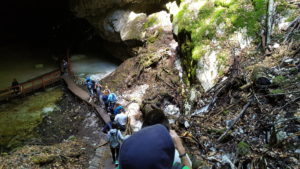 Most of ‘traditional Romania’ could be seen in the Apuseni Mountains, where most of the grass is still cut using scythes and dried in a cupcake-shaped heap, using only a couple of logs. Under these mountains there were both gold and ice. We visited an underground glacier, which was so vast that during the brief descend into the glacier’s cave, the temperature dropped radically from melting hot to wintery cold in a matter of seconds. Romania is, historically, also known for its gold, which was so numerous that a number of mountains now have a vast maze of millennia old mining tunnels running underneath them.
Most of ‘traditional Romania’ could be seen in the Apuseni Mountains, where most of the grass is still cut using scythes and dried in a cupcake-shaped heap, using only a couple of logs. Under these mountains there were both gold and ice. We visited an underground glacier, which was so vast that during the brief descend into the glacier’s cave, the temperature dropped radically from melting hot to wintery cold in a matter of seconds. Romania is, historically, also known for its gold, which was so numerous that a number of mountains now have a vast maze of millennia old mining tunnels running underneath them.
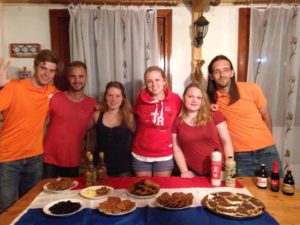 The European Night received some special cultural attention. Many participants from Eastern Europe decorated themselves in the Pan-Slavic colours (blue, red and white), some of the Spanish participants wore their football tunic and some of the Dutch wore orange (of course). The Germans had a pasta-cook-off with the Italians and the Romanians brought an abundance of homemade treats (which were really tasty). Another cool thing is that the Romanians wore traditional clothing, which is also intended for daily use. The idea behind this fashion trend is that tradition and modernity are not mutually exclusive: one can wear traditional clothing and still be hip and progressive.
The European Night received some special cultural attention. Many participants from Eastern Europe decorated themselves in the Pan-Slavic colours (blue, red and white), some of the Spanish participants wore their football tunic and some of the Dutch wore orange (of course). The Germans had a pasta-cook-off with the Italians and the Romanians brought an abundance of homemade treats (which were really tasty). Another cool thing is that the Romanians wore traditional clothing, which is also intended for daily use. The idea behind this fashion trend is that tradition and modernity are not mutually exclusive: one can wear traditional clothing and still be hip and progressive.
In German, Transylvania is called Siebenbürgen (Seven Fortresses), after the seven fortified keeps of the Saxons (German speaking immigrants), the most beautiful of which being Sibiu (Hermannstadt in German). It has retained its romantic medieval city centre, including its illustrious bridge of lies -which would crumble if one would tell a lie too big. Underneath that bridge lovers would often meet… thank the heavens the people of Sibiu are fairly honest.
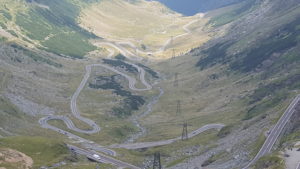 From this moment during the long trip, sleeping in the bus was very lovely, but one city still remained: Braşov, known for its wanna-be-Hollywood-sign. To get there, the bus first passed over the Transfǎgǎrǎşan road, which climbed like a wildly winding river alongside a waterfall that flowed from an icy glacier lake.
From this moment during the long trip, sleeping in the bus was very lovely, but one city still remained: Braşov, known for its wanna-be-Hollywood-sign. To get there, the bus first passed over the Transfǎgǎrǎşan road, which climbed like a wildly winding river alongside a waterfall that flowed from an icy glacier lake.
In Braşov everyone slept in a gym with a wooden-brick-floor that looked just like those in old movies. From here, the group visited an adventure park, Bran castle (on which castle Dracula was based), an old Transylvanian fortress that protected against the Ottoman invasions, Peleş castle (the most beautifully decorated castle in the world), and a swimming pool (cause, after all this cultural input, it’s nice to relax a little).
After Braşov the group only halted in Sighisoara, which was quickly referred to as ‘little Sibiu’, because of the city’s beautiful, but tiny, Medieval centre. Lastly, after nearly two weeks, (almost) everyone returned back to Cluj-Napoca, 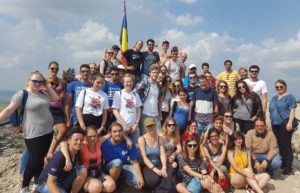 where there was a final, moving closing ceremony.
where there was a final, moving closing ceremony.
The group may have lost its energy, but never its spirit. Friendships were made for life, and the organisers and the participants all were extremely sad to let it all go. What made this Summer University so special cannot be merely captured within these words. It is a feeling one can only have by joining it, which I hope many of you do in the future.
Written by Willem Laurentzen, AEGEE-Nijmegen.

